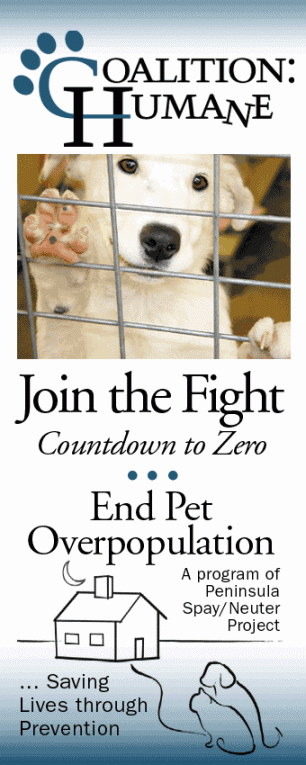
It seems even more fitting now that the Chicagoland area played host to the first national spay/neuter conference to hit the circuit! PetSmart Charities put on a great Fix It Forum October 25 - 27, 2007 in Oakbrook, IL. A few representatives of Peninsula Spay/Neuter Project were lucky enough to attend and reap the benefits of a sold-out conference filled with over 500 attendees, including over 100 veterinarians. A wealth of information was provided and we are back, raring to go!
Now we discover that Chicago (a truly big city) is advocating for TNR!
Cook County, Illinois - which includes Chicago - recently became the latest community to pass an ordinance granting formal approval of trap, neuter and return (TNR) programs to control stray and feral cats. On Oct. 16, which happens to be National Feral Cat Day, county commissioners unanimously approved TNR.
Trap-neuter-return allows volunteer caretakers and animal control officers to trap stray and feral cats, spay or neuter, ear notch (a veterinarian notches the tip of an ear for easy identification), vaccinate for rabies, microchip (for specific identification) and then return the animals to where they were trapped. Very sick cats are humanely euthanized. Kittens and friendly formerly-owned cats are adopted. Caretakers then look after the outdoor cats, offering shelter and food. As any new cat enters the colony, it's quickly spotted because there's no ear notch. That cat is then trapped and goes through the same process.
Stray and feral cats are a worldwide problem. In the U.S. alone, estimates range wildly, from half as many as there are owned cats (there are 88 million owned cats) to twice that number.
Bryan Kordis, a TNR consultant for the Humane Society of the United States and author of "Implementing a Community Trap-Neuter-Return Program" (published by the HSUS, 2007, $9.99 from www.hsus.org) says, "We know that properly implemented, TNR works." His examples range from Newburyport, MA (which went from 300 ferals to six in a dozen years) to New York City, a program Kordis helped implement, and he says, "from early indications is successful."Commissioner Mike Quigley was the original co-sponsor (with Commissioner Joan Murphy) for the Cook County ordinance. "I had heard about stray cats and know there is a problem," he comments. "I relied on what the experts had suggested, and they all said the same thing. Also, I like that TNR will save the county money."
Communities not so enlightened continue to have animal control officers attempt to eradicate stray and feral cats by trapping and then euthanizing. "It's been the conventional way to do deal with the issue for a very long time," says Cherie Travis, president of PACT Humane, Downers Grove, IL, and an animal attorney with the DuPaul University College of Law in Chicago. "Obviously, since the problem (of stray and feral cats) has only grown worse, this 'solution' has not worked. By not spending the limited resources of animal control and the cost of euthanasia, it's a savings. Also, rabies tags (for the cats which are trapped, neutered and returned) delivers some revenue (to local government). The community is also more receptive (to TNR). Even when there are nuisance calls about stray and feral cats, most people in the community don't want them killed. So, historically, nothing is done. TNR is certainly more effective than nothing."
TNR began in the United Kingdom and Denmark, and was imported to the U.S. in the late 1960s, according to Becky Robinson, president of Alley Cat Allies, a not-for-profit national group based in Washington, D.C., which supports TNR caretakers and communities seeking to deal with stray and feral cats through TNR. The TNR approach didn't really take off until the 1990s, as researchers learned the concept really does work to help reduce numbers, sometimes quite dramatically, but often more gradually.
Kordis is the first to admit that strays and ferals are a problem. They spray, yowl and fight. There's a possibility they could spread rabies, a serious public health risk.
"The yowling, fighting and spraying is greatly related to mating," says Meg Martino of the Chicago Stray Cat Coalition. "Spay/neuter makes a lot of these problems go away. And all cats spayed and neutered are also vaccinated against rabies."
However, the biggest complaint of all is that stray and feral cats kill songbirds and other wildlife.
"I'm not denying that cats kill occasional birds, squirrels, whatever they can catch - we know that's true," says Martino. "But if they're spayed/neutered, they generally stay closer to where their caretaker is. And they're also simply not as hungry and not as motivated to go after difficult to kill prey."
"TNR is the only choice I've seen that makes sense," adds Dave DeFuniak, executive director of Tree House Animal Foundation, a cat-only shelter in Chicago. "No community has animal control resources to keep up with cat reproduction."
When animal control removes some cats from a colony (they're rarely able to catch them all), a vacuum in the colony is created and the members magically and rapidly have larger litters to fill the void. "There's no way to stay ahead of that," DeFuniak says.
"When communities like Chicago and New York participate in TNR, my hope is that others all over the nation, and even animal control officers, will understand that this is our best solution for achieving a mutual goal," says Robinson.
David Dinger, vice president operations of the Anti Cruelty Society of Chicago, is elated about how TNR is making a difference across the country, "Millions of cats are out there," he says. "If we do nothing, there will be millions more. Euthanizing as we've traditionally done just doesn't work. I'm optimistic that TNR is a solution not only for outdoor cats but also to limit the numbers of kittens which pour into shelters."
Should all communities support TNR? All the experts interviewed here cheer, "Yes!"
